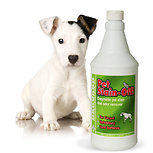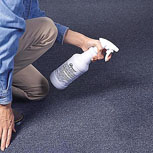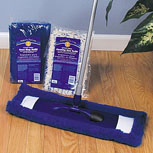Floor Care With Allergies
We don't usually give much thought to floors, especially in regards to allergies, but they are important. Pollen, mold spores, pet dander, and dust mite allergen accumulate on the floor, sometimes in the form of dust. Frequent cleaning means that there are less allergens and dust to be stirred up as you walk across the room. This means fewer airborne particles to be inhaled and to cause irritation that leads to allergic reactions or asthma attacks. For floor care with allergies in mind, read the tips below on how to care for your carpeting and flooring to deal with dust mite, mold, and pet allergies and some alternatives for people with chemical sensitivities.
Floor Care With AllergiesWhen you have allergies or asthma, the best thing to do with carpeted floors is to turn them into uncarpeted floors. The Allergy and Asthma Foundation of America (AAFA), the American Academy of Allergy, Asthma, and Immunology (AAAAI), and the Mayo Clinic advise removing carpet when possible. But sometimes replacing carpet with vinyl, hardwood, tile, or laminate is not a realistic option because of the expense involved, and sometimes people just like carpet and don't want to give it up. If you choose to keep your carpeting, there are ways to make it easier for allergy and asthma sufferers to live with carpet. Whether you have carpet or hard flooring, the most important factor in preventing allergic reactions is to keep floor surfaces clean and allergen free. As with all allergen avoidance tactics, start in the bedroom first for the most aggressive measures, including cleaning.Carpeted Floors & Dust Mite Allergy
Vacuum often. The best choice of vacuum cleaners for allergy and asthma sufferers is one with sealed HEPA filtration. This means the seams in the vacuum are sealed with gaskets to prevent air and particles from escaping from the vacuum before filtration. A True HEPA filter removes at least 99.97% of all particles that are 0.3 microns in size or larger from the exhausted air that passes through the vacuum cleaner. There are several levels of vacuums available for allergy sufferers that have advantages over standard vacuums although they are not sealed HEPA filtration. Some have True HEPA filters either included or optional, and others have HEPA-type or HEPA-like filters that are not as efficient as True HEPAs, but do help. Choose the highest level available for the price you plan to pay.
The Carpet and Rug Institute recommends that "high-traffic or pet areas should be vacuumed daily, medium-traffic areas need to be vacuumed about twice a week, and light-traffic areas should be vacuumed weekly." If the allergy or asthma sufferer must do the vacuuming, a mask to prevent inhalation of particles is advisable.
To prevent allergen build-up, keep a doormat at the entrances of your home, indoors or outdoors, to capture some dirt and allergens before they enter your home. Using air purifiers for airborne particles, vent filters to capture dust and allergens exiting from your ductwork, and furnace filters to catch particles being pulled through your HVAC system will also help reduce the amount of allergens in your home's air that settle on floors and furnishings.
|
| Product: | Where to Use: | How to Apply: | How Often: | Coverage: | Effect: | Active Ingredients: |
| AllerTech® Anti-Allergen Solution Spray | Carpets, rugs, upholstered furniture, curtains & pet bedding | Spray on after vacuuming or steam cleaning | Every 2 months | 32-oz. Bottle covers 500-800 sq. ft. | Neutralizes dust mite & other allergens | Plant-based. Odorless & colorless. Non-staining. |
| DustMitex Pre-Mixed Spray | Carpets, rugs, fabric & upholstered furniture | Spray on after vacuuming or steam cleaning | Twice a year | 32-oz. Bottle covers 100 sq. ft. | Kills dust mites | Boron compound. Odorless & colorless. |
| DustMite and Flea Control Powder | Carpets, rugs, & upholstered furniture | Mix with water & use as a spray or in a carpet cleaning machine | Twice a year | 2-lb. Bag covers 800 sq. ft. as a spray or 400 sq. ft. in a carpet cleaner | Kills dust mites | Boron compound. Odorless & colorless. |
| Allersearch ADS Spray | Carpets, rugs, & some upholstered furniture | Spray on dry surface to dampen. Allow to dry, then vacuum | Every 2-3 months | 32-oz. Bottle covers 600 sq. ft. | Neutralizes dust mite and other allergens | 3% tannic acid. Virtually odorless |
| Allersearch X-Mite Powder | Carpets, rugs, & some upholstered furniture | Brush into carpet or furniture, let dry and vacuum | Every 2-3 months | 1 lb. Bag treats 150 sq. ft. | Neutralizes dust mite and other allergens. Cleans and freshens carpet. | 3% tannic acid. Virtually odorless. |
| Allersearch ADMS Spray | Carpets, rugs, upholstered furniture, & curtains | Spray on after vacuuming or steam cleaning | Every 30 days | 32-oz. Bottle covers 600 sq. ft. | Neutralizes dust mite and other allergens | Safe, inorganic compounds. Non-staining. |
Carpeted Floors & Mold AllergyRemove carpet. If at all possible, replace carpet in the bathroom with hard flooring. With the unavoidable excess moisture and water spills in the bathroom, mold is likely to grow with carpeting. Keep a close eye on the humidity in your basement, and elsewhere in your home, so that carpet does not become damp and prone to mold. Dust mites also thrive in moist, humid environments. If humidity exceeds about 45%, you may need a dehumidifier to get rid of moisture.Cleaning your carpet. The Mayo Clinic recommends using "a dry method of cleaning so that the moisture from carpet cleaning does not provide an inviting environment for mold growth." You can use a dry carpet cleaning product to clean carpet yourself. If you get a professional carpet cleaning service, ask questions up front about the method of cleaning and how long the carpet will take to dry.Carpeted Floors & Pet Allergy The dried flakes of urine or saliva produced by pets is very sticky and adheres to carpets, hard flooring, walls, furniture ‒ actually, every surface. It is almost impossible to completely avoid pet allergens. Even if you do not have a pet, you can track pet dander into your home on your clothing, or visitors or a previous owner's pet can cause you trouble. It is easier to remove pet allergen from hard flooring, but carpet treatments (see chart above) can neutralize pet allergen when used regularly. If you have both carpet and a pet, frequent vacuuming and carpet treatment will help. Be sure to clean up pet accidents immediately to prevent this concentration of allergen from being stirred up into your breathing space. Reduce pet dander (dry skin flakes shed by your pet) at the source by regularly bathing your pet, using cleansing pet wipes, or by applying a moisturizing solution that also removes dander. Also remove pet allergens by vacuuming with a pet vacuum, and likewise remove airborne pet allergens by using a special pet furnace filter, vent filters, and a pet air purifier. The dried flakes of urine or saliva produced by pets is very sticky and adheres to carpets, hard flooring, walls, furniture ‒ actually, every surface. It is almost impossible to completely avoid pet allergens. Even if you do not have a pet, you can track pet dander into your home on your clothing, or visitors or a previous owner's pet can cause you trouble. It is easier to remove pet allergen from hard flooring, but carpet treatments (see chart above) can neutralize pet allergen when used regularly. If you have both carpet and a pet, frequent vacuuming and carpet treatment will help. Be sure to clean up pet accidents immediately to prevent this concentration of allergen from being stirred up into your breathing space. Reduce pet dander (dry skin flakes shed by your pet) at the source by regularly bathing your pet, using cleansing pet wipes, or by applying a moisturizing solution that also removes dander. Also remove pet allergens by vacuuming with a pet vacuum, and likewise remove airborne pet allergens by using a special pet furnace filter, vent filters, and a pet air purifier.
Carpeted Floors For the Chemically SensitiveEither carpet or hard flooring can be a problem if you are chemically sensitive. Although carpet has not been made with formaldehyde for over 30 years, there are still some VOCs (volatile organic compounds) that can cause problems for those who are chemically sensitive. Usually it is the adhesive used to attach the carpet fibers to the backing that causes the odor. Allowing carpet to air out for 72 hours after installation will allow nearly all odor to dissipate. When buying new carpet, look for low VOC emissions. If possible, leave the windows open, and leave home while the carpet airs. Floor cleaning products can also be a problem for the chemically sensitive. The use of vegetable-based floor care products can help prevent reactions.Uncarpeted Floors
Uncarpeted floors are more practical when it comes to allergen avoidance because they are easier to clean, and it's easier to see when they need cleaning. You have the same amount of allergen, but with hard flooring it remains on the surface, not deep in fibers, and so is easier to eliminate. With vinyl, hardwood, laminate, or tile floors, keeping the floor clean and allergen free is just as important as with carpeted floors. Vacuum often with a HEPA vacuum, and use dust-grabbing dust mops and dust cloths in between vacuuming. Wet mopping or steam cleaning removes dirt and allergens that are stubborn. If you have uncarpeted floors, you may miss the warmth of carpet. Area rugs that can be washed every two weeks in hot water or with an anti-dust mite laundry additive can provide the benefit of carpet without the difficulty of cleaning wall-to-wall carpet.
Summary
Floor care is important in reducing allergens and their symptoms. Replacing carpet with hard flooring is generally recommended, but there are ways to make living with carpet and allergies possible. Using the tips above for your particular allergy can help you in the constant fight to avoid allergens. |





